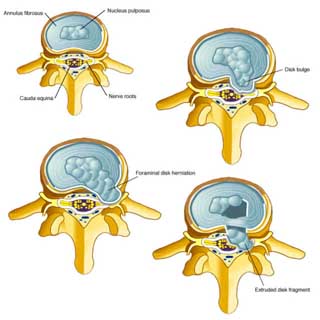Spinal Disc Problem
 A common assumption is that a spinal disc can slip which is false. Spinal disc cannot slip.
A common assumption is that a spinal disc can slip which is false. Spinal disc cannot slip.
Spinal disc depends upon the circulation of joint fluids to bring in nutrients and expel waste. If a spinal disc loses its normal motion and this pumping action is impaired, the health of the disc deteriorates. A healthy disc is flexible, like a wet sponge. A dry sponge is hard, stiff, and can crack easily. This is how many disc problems begin.
Spinal disc cannot “slip” as commonly thought. However, trauma or injury to the spine can cause discs to bulge, herniate, or worse, rupture. This can cause severe pain, putting pressure on the spinal cord and nerve roots, often interfering with their function. The disc is a small cartilage pad that is situated between spinal bones. The soft jelly-like center is contained by layers of fibrous tissues. Each disc serves as a connector, spacer, and shock absorber for the spine. When healthy, discs allow normal turning and bending.
There are different levels of spinal disc problems. Because they are attached to vertebrae, discs do not slip, but they do tear, bulge, herniate, prolapse and dessicate.
 Disc Tear
Disc Tear
The most common disc injury is a small crack or microtear in the tough, outer cartilage material of the disc called annular fibers. This allows the fluid to start leaking out, and the disc begins to wear thin.
Bulging Disc
The soft jelly-like material in the middle of the disc pushes to one side, forward or backward, and swelling occurs. The nucleus is still contained within the tough outer fibers of the disc, but can still cause pressure and painful symptoms.
Herniated Disc
The soft jelly-like material from the nucleus in the middle of the disc ruptures through the tough, outer fibers and extends to the outer edge or beyond the normal limits of the disc.
Prolapsed Disc
A piece of disc material separates away and becomes a fragment or a free-floating piece.
Dessicated Disc
The disc loses its fluid content and degenerates down to a rough, worn-down or worn-out appearance. This occurs as the bones begin to fuse to each other.
As chiropractors we help restore better motion and position to the spinal joints. Besides reducing disc bulging, better spinal function helps decrease inflammation so the slow process of healing the surrounding soft tissues can begin. Many patients have avoided needless surgery or a dependency on pain pills by choosing conservative chiropractic care for spinal disc problems.